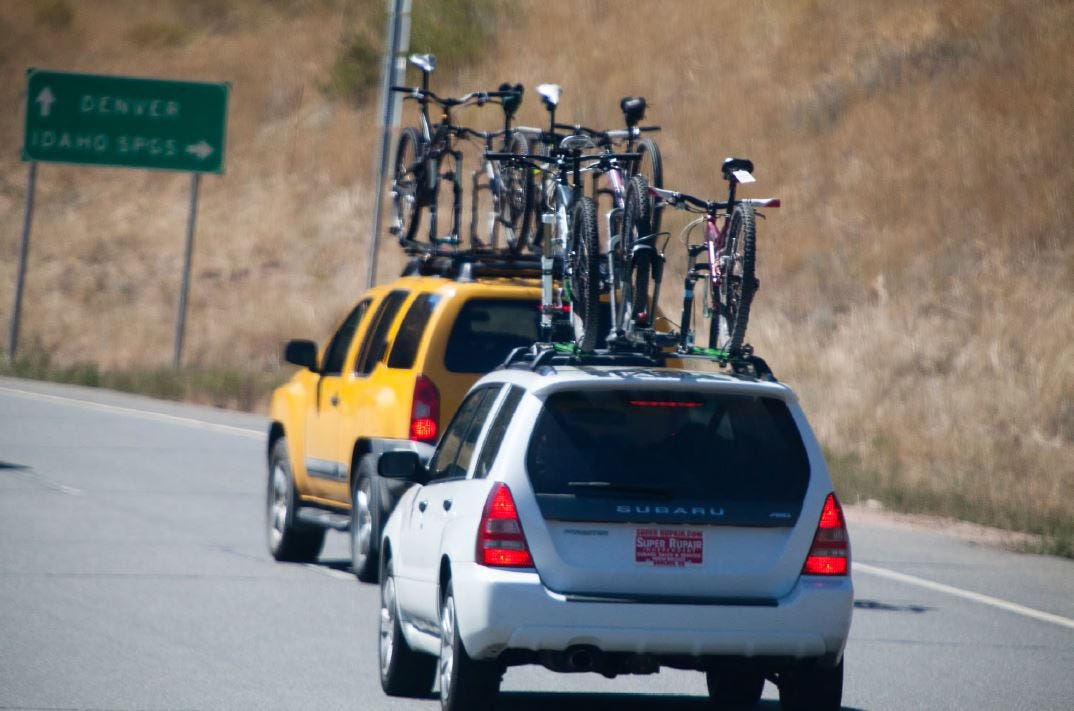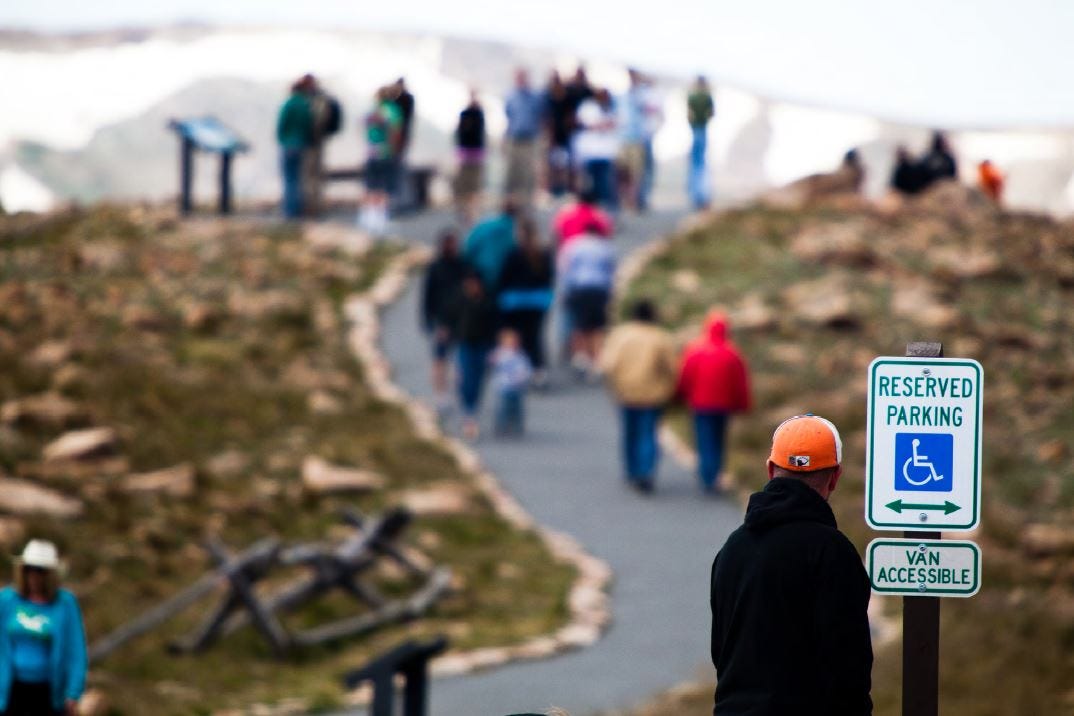Adventure - it’s the modern fashion accessory
Everybody has gotten in on the adventure glam of the last decade, but only in appearance, and the West has merely been used as the backdrop.
Rewind a few years, we had the COVID-19 pandemic. You suddenly couldn’t touch a ten year old Toyota Tacoma in Colorado for under the price of new, and new ones started selling like toilet paper off a Walmart shelf. Rewind a few years prior, and brands like REI, Backcountry, Patagonia, and others made the outdoor look the new in-style fashion. These brands were like Abercrombie was only ten years prior. Slam these two together, put the American West as the backdrop, and you have a recipe for everyone getting in on adventure … but was anyone, really?
You know what I’m talking about – how every car ad for the latest crossover-utility-vehicle shows a red dirt road out of Moab, Utah, every pharmaceutical ad shows someone hiking confidently in mountainous terrain undoubtedly shot in some new neighborhood in the mountains of Colorado’s Front Range, or how every outdoor gear brand shows people donning the latest in colors and urban fashion-fit, hiking on some overused trail highway in a national park. Adventure-glam is this year’s Gucci.
But here’s the thing about adventure – it used to include an element of going into the unknown (not just to you), doing something involving some exposure to hazard (even unanticipated ones), or going where no one has gone before (just like Captain Kirk). And almost none of the people using the term to describe what they’re doing on the weekend near Denver have any contact with any of that.
A funny little fact about the West is that, prior to cars, something like half of all people who attempted to cross the plains and mountains to go West died. They died from all kinds of things - anything from infections, to encounters with wildlife, to native americans killing them, bad weather – they died from exposure to hazards that were inherent to the environment here and were not yet controlled by the domestication of basically everything.
Are any of the transplants and tourists to the West doing anything resembling “adventure” anymore? Especially those who finally moved here after 200 years of domestication and urban development to make the place safe for them?

The answer is certainly – not at all.
I mean, maybe to them there’s risk perceived – and maybe for them, the risk is real, even if a direct result of lack of preparation and inspiration to go participate thanks to something they saw on social media. I guess it’s challenging to walk on a dirt path that was engineered and built by people for recreation, as most of our roads and trails in the West are now, making the adventure of today little different from canned hunts from the past where a caged lion would be shot by the great hunter as a trophy.

As more and more people have moved to the West, there’s one sad truth at the root of my critique; The West has been domesticated to a point where ‘adventure’ is now entirely staged in domesticated spaces, made safe for people, and is almost always near substantial infrastructure. Walking on a trail in California that is walked by hundreds of thousands or millions of people doesn’t really pass as adventure, because is it really adventurous just because they’re on dirt, rather than concrete? There are concrete walking paths in Colorado that see fewer people walking on them than Colorado’s domesticated 14,000 foot peaks (“14ers” as the boosters and posers call them).
And this isn’t to say that adventure is impossible now – I’m merely pointing out that it’s a word that’s used overly frequently and as hyperbole rather than with literal accuracy.
Adventure in the West (and maybe parts of the eastern US) is still possible, but it takes a lot of effort to achieve in any authentic way. Escaping crowds of people gets harder and harder, especially as the Federal land agencies fund the grading and smoothing of almost every road, to make sure it’s accessible, even to the most adventurous (tone:sarcasm) … but you can get away, still encounter real risk, and get out to points where search and rescue would even have a hard time getting to you.

The use of adventure in a hyperbolic way has watered down what this means, who does this, and what the truly intrepid individuals are doing. If we were talking about culturally or religiously unique clothing, and someone using them for entertainment or hyperbolically, it would be called cultural appropriation. Maybe we should start looking at adventure that way?
Getting under the skin of the issue, adventure once implied there was skin in the game, and substantial skills needed to even begin, deep personal drives to go see what’s out there, and the ability to travel and orient oneself without the help of a cellular phone with a GIS antenna in it. There was only adventure when you were really wandering out into something unknown. The definition is changing via misuse and the fashionable hyperbole of today.
The hiking, climbing, and other trails in the West aren’t all Disney-level adventure yet, but those thinking they’re adventurous for driving up a dirt road just … aren’t. Not even close. Those finding places to go via social media posts, trip reports, apps that show how to get there, what to do, and what you’ll see … those using pre-vetted information about what they’ll see aren’t adventurous either. They’re followers, not adventurers.
What I’m getting at is that the West has changed substantially as it has urbanized and been traveled over and over and over by tourists seeking imagery while using their REI-purchased outdoor costumes. Yeah, I called them costumes. And in this urbanization, the potential for adventure or adventurousness has disappeared at an even greater rate. With every person comes more need for infrastructure, more tax funding to make that infrastructure, more demand for being able to find and see places without effort. And with that, the potential for adventure disappears.

The West is synonymous with adventure. Indiana Jones rode through Monument Valley on a horse, John Wayne made people believe that California and Texas were part of the West and sold the hell out of the imagery, and the 127 Hours guy who cut off his own arm made millions off his book and movie royalties - that happened in the West, too. So, when it looks like the potential for authentic adventure is disappearing at the hands of uncontrolled growth, and the building of infrastructure intended to make “adventure” easier for “more people,” just know that the feeling you’re having while processing these words is called “cognitive dissonance.” The dissonance is about the fact that the imagery and the reality are now disconnected.
We all use infrastructure on a daily basis, so this critique is really about the nuance in use of language, and in the way the language, landscape, and culture stemming from these elements are changing. An element of that nuance is that it looks like few to none of the people who have decided they inhabit the ‘adventurous space’ seem to be authentically part of it at all. Hiking Gray’s Peak along I-70 in Colorado is … not … adventurous. It’s a couple mile stroll up a gradual grade, to the top of a hill of dirt. Albeit a large one, but it’s frequented by something like 1 million people per year. That’s something like 83,000 people per month. I fudged most of those numbers from some faded memory, but the essence is there; An ungodly number of people hike this mountain every year.
If American malls saw 80,000 people per month each, Amazon wouldn’t need to exist.
Next time you hear someone talking about their adventure, consider whether that word is being used literally or hyperbolically. The relativistic use of the word waters it down – and for those who still go do, practice, study, make their tools, and take real risks, the misuse of the language smells a lot like some unrecognized form of cultural appropriation. The hyperbolic use of the word is part of an imagery that seems to parallel the development of disingenuous social media identities. The current popular identity construction appears to entirely use non-urban spaces as a backdrop, and little more. “Look at me, look at me in this place, and look how different this place is from where you went this summer.” That’s not an adventure – it’s a caged lion stuffed in your game room.
The Fleeting West is written by a rooted westerner with more photos of traffic jams in the mountains and museumified landscapes than anyone should ever care to admit.





Don’t forget to stop by the gift shop to pick up some rare native plants to take back to your dingbat. 🤡 https://www.latimes.com/lifestyle/story/2022-09-29/joshua-tree-native-plants-mojave-desert-land-trust